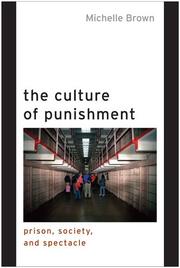| Listing 1 - 4 of 4 |
Sort by
|

ISBN: 0814739040 9780814739044 9780814799994 9780814791004 081479999X 081479100X Year: 2009 Publisher: New York, N.Y. New York University Press
Abstract | Keywords | Export | Availability | Bookmark
 Loading...
Loading...Choose an application
- Reference Manager
- EndNote
- RefWorks (Direct export to RefWorks)
America is the most punitive nation in the world, incarcerating more than 2.3 million people—or one in 136 of its residents. Against the backdrop of this unprecedented mass imprisonment, punishment permeates everyday life, carrying with it complex cultural meanings. In The Culture of Punishment, Michelle Brown goes beyond prison gates and into the routine and popular engagements of everyday life, showing that those of us most distanced from the practice of punishment tend to be particularly harsh in our judgments. The Culture of Punishment takes readers on a tour of the sites where culture and punishment meet—television shows, movies, prison tourism, and post 9/11 new war prisons—demonstrating that because incarceration affects people along distinct race and class lines, it is only a privileged group of citizens who are removed from the experience of incarceration. These penal spectators, who often sanction the infliction of pain from a distance, risk overlooking the reasons for democratic oversight of the project of punishment and, more broadly, justifications for the prohibition of pain.
Prisons --- Imprisonment --- Punishment --- Dungeons --- Gaols --- Penitentiaries --- Correctional institutions --- Prison-industrial complex --- Confinement --- Incarceration --- Corrections --- Detention of persons --- Penalties (Criminal law) --- Penology --- Impunity --- Retribution --- Social aspects. --- Social aspects --- School-to-prison pipeline --- Punishment - Social aspects --- Imprisonment - Social aspects --- Prisons - Social aspects
Book
ISBN: 1283206358 9786613206350 1441153535 Year: 2005 Publisher: London : Continuum International Publishing,
Abstract | Keywords | Export | Availability | Bookmark
 Loading...
Loading...Choose an application
- Reference Manager
- EndNote
- RefWorks (Direct export to RefWorks)
The kingdom best remembered for Offa and his famous dyke was not only a dominant power on the island of Britain in the eighth century, but also a significant player in early medieval European politics and culture. Although the volume focuses on the eighth and ninth centuries when Mercian power was at its height, it also looks back to the origins of the kingdom and forward to the period of Viking settlement and West Saxon reconquest. With state-of-the-art contributions from experts in palaeography, art history, archaeology, numismatics and landscape - as well as from historians - this book esta
Book

ISBN: 9783110557671 9783110558609 3110557673 3110558602 Year: 2018 Volume: 2 Publisher: Berlin Boston
Abstract | Keywords | Export | Availability | Bookmark
 Loading...
Loading...Choose an application
- Reference Manager
- EndNote
- RefWorks (Direct export to RefWorks)
According to a longstanding interpretation, book religions are agents of textuality and logocentrism. This volume inverts the traditional perspective: its focus is on the strong dependency between scripture and aesthetics, holy books and material artworks, sacred texts and ritual performances. The contributions, written by a group of international specialists in Western, Byzantine, Islamic and Jewish Art, are committed to a comparative and transcultural approach. The authors reflect upon the different strategies of »clothing« sacred texts with precious materials and elaborate forms. They show how the pretypographic cultures of the Middle Ages used book ornaments as media for building a close relation between the divine words and their human audience. By exploring how art shapes the religious practice of books, and how the religious use of books shapes the evolution of artistic practices this book contributes to a new understanding of the deep nexus between sacred scripture and art.
Aesthetics --- Art and religion --- Religious literature --- Sacred books --- 291.8 --- 22:7 --- 22:7 Bible et art --- 22:7 Bijbel en kunst --- Bible et art --- Bijbel en kunst --- Religious aspects --- History and criticism --- Bronnen van de godsdienst: openbaring in heilige boeken en traditie; religieuze beslissingen --- 291.8 Bronnen van de godsdienst: openbaring in heilige boeken en traditie; religieuze beslissingen --- Art --- Arts in the church --- Religion and art --- Religion --- 091:22 --- 091:22 Bijbels--(handschriften) --- Bijbels--(handschriften) --- Radio broadcasting Aesthetics --- Art and religion. --- Religious aspects. --- History and criticism. --- Book illumination. --- Book religion. --- Materiality. --- Ornament.
Book

ISBN: 3110447169 3110449102 9783110449105 9783110449112 3110449110 9783110635294 3110635291 3110438569 9783110438567 9783110447163 Year: 2016 Publisher: Berlin Boston
Abstract | Keywords | Export | Availability | Bookmark
 Loading...
Loading...Choose an application
- Reference Manager
- EndNote
- RefWorks (Direct export to RefWorks)
Aldred's interlinear gloss to the Lindisfarne Gospels (London, British Library, MS Cotton Nero D.IV) is one of the most substantial representatives of the Old English variety known as late Old Northumbrian. Although it has received a great deal of attention in the past two centuries, there are still numerous issues which remain unresolved. The papers in this collection approach the gloss from a variety of perspectives - language, cultural milieu, palaeography, glossography - in order to shed light on many of these issues, such as the authorship of the gloss, the morphosyntax and vocabulary of the dialect(s) it represents, its sources and relationship to the Rushworth Gospels, and Aldred's cultural and religious affiliations. Because of its breadth of coverage, the collection will be of interest and great value to scholars in the fields of Anglo-Saxon studies and English historical linguistics.
English language --- English Language --- English --- Languages & Literatures --- Germanic languages --- Dialects --- Lindisfarne Gospels --- Northumbria (Kingdom) --- Languages --- Codex Lindisfarnensis --- Glosses. --- Lindisfarne Gospels. --- Old English. --- Old Northumbrian.
| Listing 1 - 4 of 4 |
Sort by
|

 Search
Search Feedback
Feedback About UniCat
About UniCat  Help
Help News
News